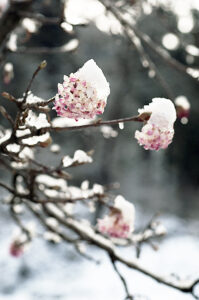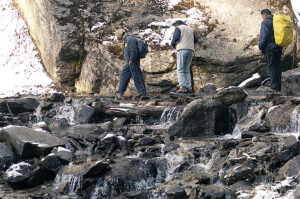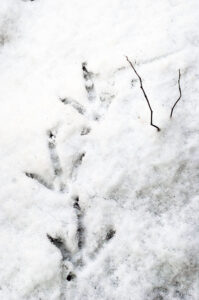Kaj Halberg - writer & photographer
Travels ‐ Landscapes ‐ Wildlife ‐ People
India 2008: Mountain goats and frozen flowers
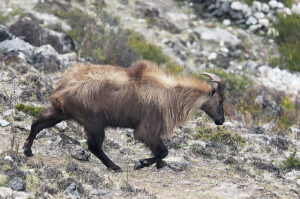
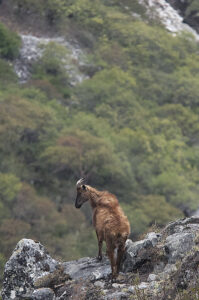
The Indian langurs, as well as many other monkeys, are described in depth on the page Animals – Mammals: Monkeys and apes.
Along the road, various plants are in bloom, including a very common species of St. John’s wort, Hypericum oblongifolium, Asian butterfly-bush (Buddleja asiatica), and Phlogacanthus thyrsiformis, a magnificent shrub of the acanthus family (Acanthaceae), which has large, reddish-brown inflorescences.
On a wet rock, we observe a yellow species of primrose, Evotrochis floribunda, previously known as Primula floribunda, which is distributed in montane areas between Afghanistan and western Nepal. Members of this genus differ from most other primroses by having several umbels up the stem. In a marshy ditch beneath the rock, we find a species of helleborine, Epipactis veratrifolia, with beautiful yellow-green petals, streaked with reddish-brown.
Near the city of Uttarkashi, many Royle’s spurges (Euphorbia royleana) grow on a dry slope. This species, which resembles a cactus, is utilized in local folk medicine, and some people regard it as a magical plant, which can protect houses against lightning. It is described in depth on the page Plants: Plants in folklore and poetry.
We spend the following night in a forest rest house just outside Uttarkashi. In the morning, we notice a rhesus monkey (Macaca mulatta), sprawled along a branch. The troop, to which it belongs, has spent the night in the pine trees around the rest house. In the grass, we find a remarkably well camouflaged praying mantis, which resembles a twig.
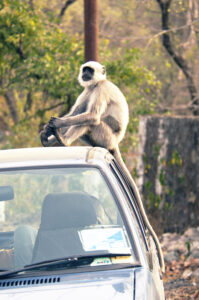


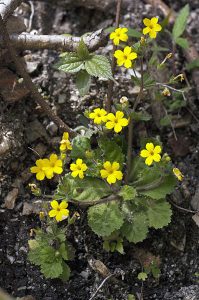
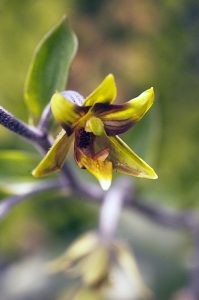
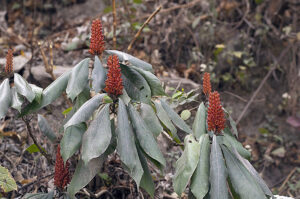

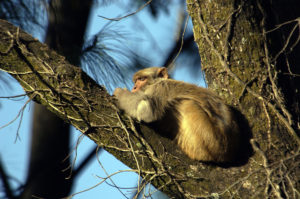
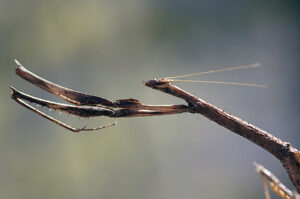
In the village, we pay a visit to a local women’s group, whose members create art from dead branches that have been washed up along the river banks. Faces have been applied to some, while others resemble birds or dinosaurs. Before being sold to tourists, the branches are polished and varnished.
Initially, the walk along the Asi River is on a fairly level trail, giving us ample opportunity to botanize on the way. We encounter many species of blooming herbs, including Himalayan peony (Paeonia emodi), with large white flowers. This species is the only peony in the Himalaya, distributed from Afghanistan eastwards to western Nepal and extreme south-western Tibet.
We also observe a pale-blue species of sage, Salvia lanata, a small-flowered member of the mint family, Micromeria biflora, a species of cranesbill, Geranium nepalense, and yellow-flowered strawberry (Potentilla indica), which, incidentally, is not a strawberry, but a cinquefoil. Its fruits are strawberry-like, but completely dry and without taste.
Various shrubs grow along the trail, including the fragrant Deutzia staminea, of the family Hydrangeaceae, which is widely distributed in the Himalaya, from Pakistan eastwards to south-western China. It grows at forest edges and in other open areas, at elevations between 1,100 and 3,200 m.
Smaller trees include winged prickly-ash (Zanthoxylum alatum), whose seeds are used medicinally for various ailments, including toothache, coughing, and rheumatism, and palmate fig (Ficus palmata), which was first described in Yemen by Swedish naturalist Pehr Forsskål (1732-1763), who participated in the Royal Danish Expedition to Arabia 1761-1767. In Yemen, he also described another species of fig, Ficus morifolia, which, however, is today regarded as belonging to the F. palmata complex, whose leaf shape is very variable.
The fascinating, albeit short, life of Pehr Forsskål is related on the page People: Pehr Forsskål – brilliant Swedish scientist.
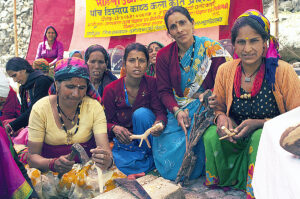
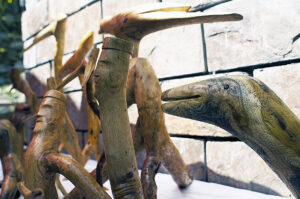

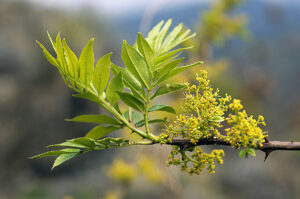
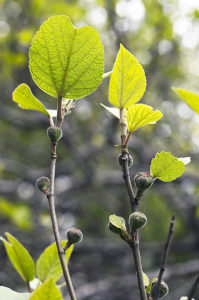
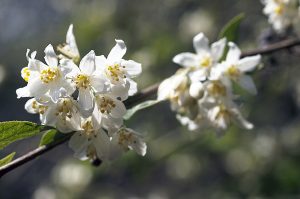
We spend the night in a forest rest house at the outskirts of the village. Many shrubs of Himalayan box (Buxus wallichiana) are flowering in this area, as well as numerous Himalayan hornbeams (Carpinus viminea), which has long, pendent, reddish-brown catkins. On many trees around the village, foliage and thinner branches are often lopped for fodder, which cause the leaves to grow densely on thicker branches, lending the entire tree a stunted and fuzzy look.
Birdlife is rich in this area, and we notice species like the black-and-white kalij pheasant (Lophura leucomelanos), crested goshawk (Accipiter trivirgatus), the gorgeous maroon oriole (Oriolus traillii), and red-billed blue magpie (Urocissa erythrorhyncha), the latter in courtship display outside the rest house. The female is sitting on a branch, shaking her wings, while the male jumps back and forth in front of her, or over her back, while turning his head and tail from one side to another. His tail feathers are spread out, making the white spots on the outer tail feathers visible.
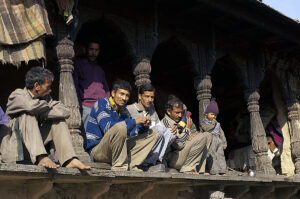

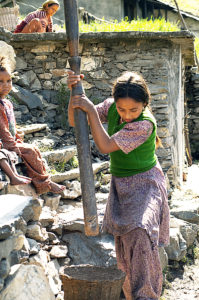

Along the trail, hairy bergenia (Bergenia ciliata) is quite common on rock faces, and we notice a lovely fragrance, emitted by the Himalayan butterfly-bush (Buddleja crispa). The Nepalese pear (Pyrus pashia), is a small tree, which displays a profusion of white flowers. This species, whose fruits are edible, is widely distributed, from Afghanistan eastwards to China and Southeast Asia.
The forest now contains trees like a species of maple, Acer sterculiaceum, and Rhododendron arboreum, with clusters of bright red inflorescences. The intensity of the red colour decreases with higher altitude, and near the upper limit of the occurrence of this species, around 3,800 m, you sometimes encounter trees with white flowers. This species is among the tallest of rhododendrons, growing to a height of 15 m. It is very common in the entire Himalayan range, as well as in montane areas of South India, Sri Lanka, northern Thailand, and northern Vietnam. This species, and many other rhododendrons, are described on the page Plants: Rhododendrons.
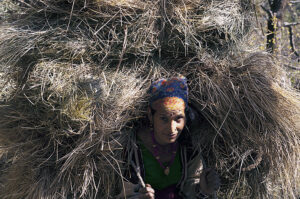
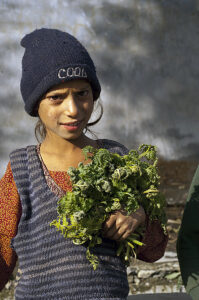
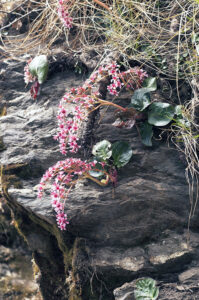
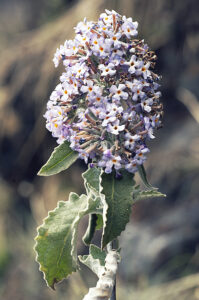

Birds in this forest include Himalayan monal pheasant (Lophophorus impejanus), which, in Nepal, is called ’the bird of nine colours’, in allusion to the brilliant plumage of the cock. Pictures, depicting this species, are shown on the page Animals – Birds: Birds in the Himalaya.
We also observe two vultures, Himalayan griffon vulture (Gyps himalayensis) and lammergeier (Gypaetus barbatus), the bright red long-tailed minivet (Pericrocotus ethologus), the blue-and-white ultramarine flycatcher (Ficedula superciliaris), and white-collared blackbird (Turdus albocinctus), whose male resembles the Eurasian blackbird (T. merula), but has a white collar, which merges into a white throat.
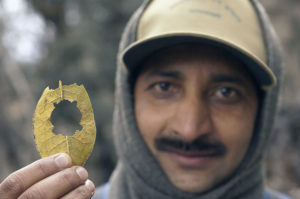
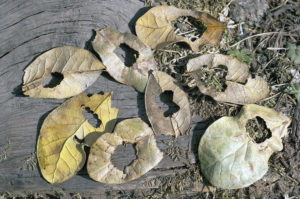
A small Hindu shrine is situated at the lakeside, indicating the status of the lake as a pilgrimage site. However, it is too early in the year for pilgrimages, and we are the only guests in the lodge at the opposite side of the lake.
I walk up a tiny side valley on the lookout for a troop of pale-armed langurs (Semnopithecus schistaceus), several of which live in this area. This langur is a large species of leaf-monkey, found at medium altitudes in the Himalaya, but occasionally straying to 4,000 m.
I soon spot a troop, whose members are busy eating flowers of large-flowered viburnum (Viburnum grandiflorum). They are rather confiding, letting me approach quite close. Large-flowered viburnum is one of the few Himalayan trees, which bloom in winter and early spring at higher altitudes. It is quite common in temperate forests in the western parts of the Himalaya.
Birdlife is sparse here, and I observe very few species, including rufous-naped tit (Periparus rufonuchalis) and Eurasian tree creeper (Certhia familiaris).
On my way back towards the lodge, I encounter a Royle’s pika (Ochotona roylei), the commonest pika, or mouse-hare, in the Himalaya. These small animals, comprising about 12 species in Central and East Asia, resemble rodents, but are close relatives of rabbits and hares. During the summer months, they collect large amounts of grass and other plants to store as winter food, as they do not hibernate.
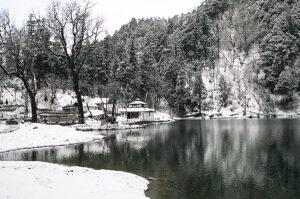
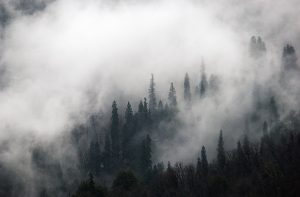
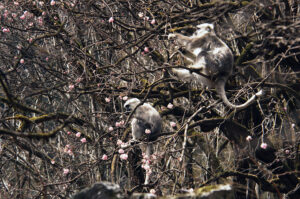

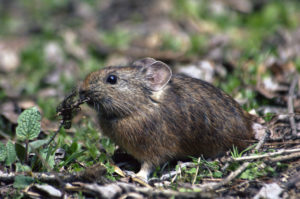
Until now, the weather has been pleasantly warm and sunny. The following morning, however, the ground is covered in a thick layer of snow. Branches and flowers are covered in a thin layer of ice, which fell as snow the previous night, then froze.
It is very cold, which means that the snow higher up will not melt for some time, thus making it very difficult for us to continue our hike towards the Darwa Pass. Instead, we decide to commence our return hike to Sangam Chatti, taking our time on the way.
As we are walking along a trail, which to one side has a fairly steep rock face, and to the other an abyss, I am lagging a bit behind. Suddenly the air seems to explode of activity: Three Himalayan tahrs, a species of mountain goat, are tearing down the slope, landing on the trail between my companions and me. Here they only hesitate a second, before throwing themselves over the edge, and seconds later we observe them running at the foot of the rock wall, 50 m or more below.
From the edge of the abyss, we scan the rock wall for ledges, which the animals could possibly have used, but we fail to see any that we think would be wide enough for them to have foothold.
What strength and virility!
